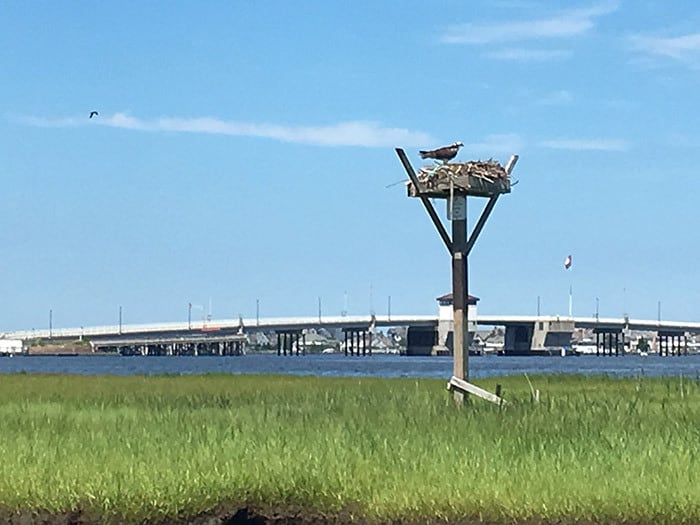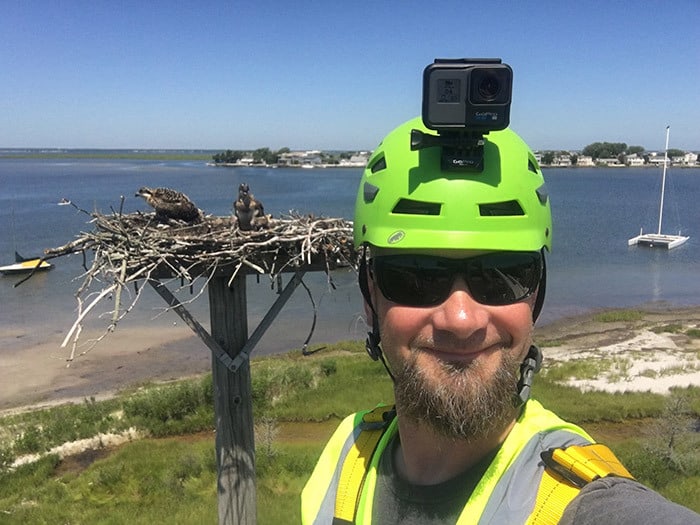
OCEAN COUNTY – Preserved open space areas in the salt marshes and wetlands of Barnegat Bay have provided a huge role in the recovery of the osprey population, and despite dense development along the New Jersey coastline, nests can be found from Sandy Hook to Cape May.
On Barnegat Bay, virtually every existing osprey nest is occupied, said Ben Wurst, habitat program manager for Conserve Wildlife Foundation of NJ.
In general, the ospreys on Barnegat Bay are doing very well, Wurst said, who along with Kathleen Clark of the NJ Division of Fish and Wildlife produce the Osprey Project report in New Jersey, a publication that reports on the osprey population count.
According to the 2017 Osprey Project report, there are 112 known osprey nests on Barnegat Bay and 115 young, up from 76 nests and 94 young, according to the 2013 report.

“We’re finding that the ospreys are building more nests on natural structures where there are large deciduous trees that are dead, especially on Sedge Island off Island Beach State Park, where there are about 30 occupied nests,” Wurst said from the field.
Wurst helps manage and protect ospreys as part of the NJ Osprey Project, which raises private funding to help ospreys in New Jersey.
Since 2004 they have installed over 100 nesting platforms throughout New Jersey, mostly in areas of Barnegat Bay, Little Egg Harbor and Great Bay where suitable habitat exists with few nesting structures.
According to the 2017 report, 72 percent of all ospreys nesting in New Jersey rely on man made nesting platforms.
Osprey, also called sea hawk, river hawk and fish hawk, have made a remarkable recovery since 1973 when they were listed as endangered by the NJ Division of Fish Game and Wildlife.
Due to the effects of DDT (which caused osprey reproduction to fail) and a loss of habitat when trees were cut down for development, their population dropped from some 500 nesting pairs to only 53 in the state.
With the banning of DDT in New Jersey in 1968, the efforts of state biologists who moved eggs and fledglings to nests where DDT was not used, and coordinated efforts to construct nesting platforms, the osprey status was upgraded to threatened in 1986 when their population had reached some 100 nesting pairs.

Another threat to adult ospreys is electrocution, where the utility infrastructure not designed to be bird-friendly, Wurst said.
Good Luck Point in Berkeley is the site of a former telecommunications facility where hundreds of telephone poles were taken down last year as part of a US Fish and Wildlife project in the Edwin B. Forsythe Refuge.
Osprey had built some 16 nests atop some of the poles, and when they removed the poles contractors left about 14 of the poles that they trimmed down and built nesting boxes atop for returning ospreys, Wurst said.
Ospreys are highly migratory and they spend their winters in South America, with the largest concentration in Columbia, Ecuador and Brazil, which biologists have learned through a federal USGS bird banding program and aerial studies.
The females migrate south first, usually sometime in August, and in September the males and juveniles leave New Jersey, Wurst said.
Ospreys have a high level of fidelity and pairs mate for life, although they do not spend their winters together. The male returns to New Jersey first – usually in mid- to late- March, and when the female returns the male performs a “sky dance,” or a mating ritual where he flies above their nest in a courtship display, Wurst said.
“He might carry a fish, which shows a successful hunt, or he might be holding onto nesting material. It’s interesting to observe this behavior. It’s unique to see,” he said.

The male also emits a high whistle-like call during mating season when the ospreys spruce up their existing nests, making them larger and thicker.
The female gestates from late April to early May, and she does about 70 percent of the incubation during the average 36-day brooding period, Wurst said. From April until August the female hardly leaves the nest at all.
The female osprey can produce three to four eggs a year with an average of two surviving per nest, he said. Once the young ospreys learn to fly, usually in August, the females finally get to leave the nest to forage for food. The juveniles learn to forage on their own before migrating south in September.
After the birds migrate, Wurst and a group of volunteers clean up the decomposing nests – which can weigh up to 200 pounds – so they don’t get blown off in the winter and they are still intact when the birds return in the early spring.






